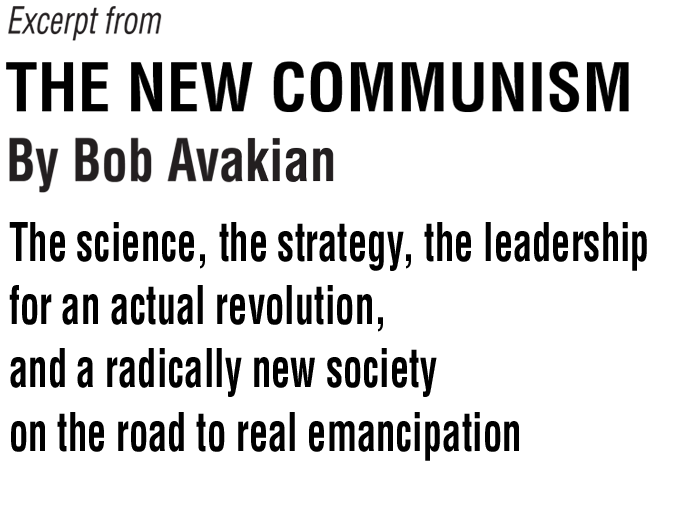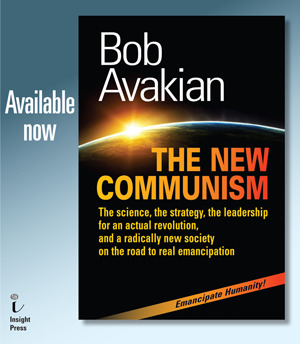
Editors' note: The following is an excerpt from the new work by Bob Avakian, THE NEW COMMUNISM. In addition to excerpts already posted on revcom.us, we will be running further excerpts from time to time on both revcom.us and in Revolution newspaper. These excerpts should serve as encouragement and inspiration for people to get into the work as a whole, which is available as a book from Insight Press. A prepublication copy is available on line at revcom.us.
This excerpt comes from the section titled "III. The Strategic Approach to An Actual Revolution."
Excerpt from the section:
Forces For Revolution
Let’s dig further into the strategic approach to revolution. What are the main forces for revolution, and what are other groups in society where large numbers of people have to be won either to be actively involved, or to be supportive, or at least to have a stance of “friendly neutrality” toward the revolution (in other words, at least not opposing it)? Obviously, this relates to the point I was emphasizing before about not being encircled, surrounded, and crushed. What are key contradictions that have to be confronted—where necessity has to be transformed into freedom and initiative for the revolutionary forces, in significant ways—to create the basis to go all-out with a real chance of winning?
First, it is important to recognize that revolution can not and will not be made by just spreading the idea of revolution around, and perhaps getting some positive responses. (Hey, thumbs up on Facebook!... Tweet out a message in favor of revolution!) Yes, it is very important to propagate the need for revolution, in a living and compelling way; but here is a point that needs to be emphasized: Accumulating organized forces for revolution is, and must be, a key objective in building toward an actual revolution; and whether or not real advances are continually being made in accumulating such organized forces is a key measure of progress—or lack of progress—in building the movement for an actual revolution. Here we can take something from Marx and adapt it to the current point: Accumulate, Accumulate, Accumulate!—Accumulate more and more capital!—that, said Marx, is the Moses and prophets for the bourgeois. Well, we can say for the proletarian revolution: Accumulate, Accumulate, Accumulate!—Accumulate organized forces for this revolution!—that must be a crucial commandment and guide!
And it’s not just accumulate over here, off in some corner. We could put it this way: It’s accumulate, impact; accumulate further, impact more; accumulate further... and on and on—even while taking into account the larger picture of what’s happening out in the world at large, as is pointed to at the beginning of Part 2 of Making Revolution and Emancipating Humanity. What do I mean by accumulate, impact? I mean that when you have organized forces, you can have a magnified impact on political situations and on the political terrain overall. To just take an important but relatively small-scale example, compared to the society as a whole, imagine if, in these upsurges in Ferguson or in Baltimore, you had an organized force of revolutionary communists of even a hundred people who were able to come on the scene, putting forward that program and organizing people around that program in the midst of that upsurge—think of the way that you could change all the dynamics in that situation. Whereas, if you have a few people there, who are even doing very good work, your ability to impact that situation is gonna be so much more limited. Now, you still have to try to impact it to the maximum degree—and, to do that, one of the things you have to do is to get very good at agitation, which is something we really need to strengthen and develop. But imagine if you could have a major impact in situations like this.
I was watching this thing on CNN when Don Lemon was out in the street interviewing somebody in the aftermath of the massacre of Black people in that church in South Carolina. Now, someone portrayed Don Lemon this way, and I think this really captures something about the role he plays: “I’m Don Lemon—I’m not really a Black man, but sometimes I play one on TV.” That gets to an important aspect of the role he plays as a puppet for the powers-that-be. But, in any case, Don Lemon was out interviewing somebody, playing his usual Uncle Tom role, and this Black woman came up behind him and started yelling, and they were live so it was hard for them to cut away, it took them a while to cut away. She started yelling, “Talk about the anger, Don. Don’t talk about the forgiveness, talk about the anger, talk about the anger, Don. Obama’s an Uncle Tom, too, Don. Talk about how Obama’s an Uncle Tom, Don. Talk about the anger. Are you talking about the anger, Don? Don, you’re an Uncle Tom.” Now, this is one woman standing behind him. Imagine if you had a hundred people, not saying exactly what that woman was saying but even more impacting the situation with compelling agitation proceeding from a revolutionary communist understanding. Then it changes everything. It changes the whole terrain—even with that number of organized forces, you’re changing the whole terrain. And then every force in society has to react differently.
Or think about this: Every time the masses rise up now, you have this situation where—here they come again—these “community leaders,” which is an updated version of what the ruling class and its mouthpieces used to call “Responsible Negro Leaders.” They are mobilized by the ruling class: religious figures of various kinds (not all of them, but too many of them), so-called community leaders, and others, including some who claim to be on the side of the people—they come out there in the situation where the people are angry, they’re in the street and they’re confronting the police, and these forces form a line, linking arms together, and they face the people. Now imagine if you had a force of even 30 people in that situation that came out there and said, “You motherfuckers are facing the wrong way! If you’re supposedly standing with the people, you should be forming a line opposing the pigs. Those are the ones harming the people. Turn around and face down the pigs!” You change the whole terms—and then the Don Lemons really have to “go to commercial!” You are affecting the terrain by having organized forces united around a revolutionary line. Even in a situation like that, it goes out to the world, especially in this age of the internet. It goes all over the place. And then people do want to know: Who are those forces that did that? Who are those forces that stood with the people and stood between the police and the people, facing the police and not allowing the police to attack the people? Who are those people who, while they were doing this, said, “We’re doing this for revolution, to get rid of this brutality and murder, and all the other shit that people are going through in this country and around the world”? See, when you have organized forces moving like that, then you seriously impact the situation, and then you draw more forces. It’s not that they all join up with you right away, or that you should bring them fully into the ranks of revolution right away, before they even have a chance to get a basic understanding of what this revolution is all about. There’s work and struggle that has to go on. But you’re able to get this dynamic going where you’re growing, you’re wielding your organized forces for revolution in a way to significantly impact society and drawing people to you, and through struggle accumulating more organized forces... and then you are able to do more to affect the situation, once again through a lot of struggle. This is the dynamic we have to advance while, once again, not narrowing our sights to just that dynamic, but looking at the whole world and how we affect the whole world toward the goal of revolution. But this is why we have to be seriously working to accumulate organized forces for revolution and to wield those forces to impact the terrain, and accumulate and impact more, while not approaching that in a narrow and linear way (as if everything will just go forward, from advance to advance, in a simple straight line, directly out of what we’re doing).
This is the correct basis for the point that’s made, and for correctly understanding the point that’s made, in “On the Strategy for Revolution,” about the “thousands” and their relation to the “millions.” It’s not just some vague notion of “thousands of people” who sort of go “thumbs up” on the idea of revolution (or even are very enthusiastic about it). If you’re talking about leading millions, you need an organized force of thousands of people, a growing number of people, in the thousands, who are oriented, organized, trained and led to be an actual revolutionary force and pole of attraction—not some vague bunch of electrons floating around with no real solid core.
Contents
Publisher's Note
Introduction and Orientation
Foolish Victims of Deceit, and Self-Deceit
Part I. Method and Approach, Communism as a Science
Materialism vs. Idealism
Dialectical Materialism
Through Which Mode of Production
The Basic Contradictions and Dynamics of Capitalism
The New Synthesis of Communism
The Basis for Revolution
Epistemology and Morality, Objective Truth and Relativist Nonsense
Self and a “Consumerist” Approach to Ideas
What Is Your Life Going to Be About?—Raising People’s Sights
Part II. Socialism and the Advance to Communism:
A Radically Different Way the World Could Be, A Road to Real Emancipation
The “4 Alls”
Beyond the Narrow Horizon of Bourgeois Right
Socialism as an Economic System and a Political System—And a Transition to Communism
Internationalism
Abundance, Revolution, and the Advance to Communism—A Dialectical Materialist Understanding
The Importance of the “Parachute Point”—Even Now, and Even More With An Actual Revolution
The Constitution for the New Socialist Republic in North America—
Solid Core with a Lot of Elasticity on the Basis of the Solid Core
Emancipators of Humanity
Part III. The Strategic Approach to An Actual Revolution
One Overall Strategic Approach
Hastening While Awaiting
Forces For Revolution
Separation of the Communist Movement from the Labor Movement, Driving Forces for Revolution
National Liberation and Proletarian Revolution
The Strategic Importance of the Struggle for the Emancipation of Women
The United Front under the Leadership of the Proletariat
Youth, Students and the Intelligentsia
Struggling Against Petit Bourgeois Modes of Thinking, While Maintaining the Correct Strategic Orientation
The “Two Maximizings”
The “5 Stops”
The Two Mainstays
Returning to "On the Possibility of Revolution"
Internationalism—Revolutionary Defeatism
Internationalism and an International Dimension
Internationalism—Bringing Forward Another Way
Popularizing the Strategy
Fundamental Orientation
Part IV. The Leadership We Need
The Decisive Role of Leadership
A Leading Core of Intellectuals—and the Contradictions Bound Up with This
Another Kind of “Pyramid”
The Cultural Revolution Within the RCP
The Need for Communists to Be Communists
A Fundamentally Antagonistic Relation—and the Crucial Implications of That
Strengthening the Party—Qualitatively as well as Quantitatively
Forms of Revolutionary Organization, and the “Ohio”
Statesmen, and Strategic Commanders
Methods of Leadership, the Science and the “Art” of Leadership
Working Back from “On the Possibility”—
Another Application of “Solid Core with a Lot of Elasticity on the Basis of the Solid Core”
Appendix 1:
The New Synthesis of Communism:
Fundamental Orientation, Method and Approach,
and Core Elements—An Outline
by Bob Avakian
Appendix 2:
Framework and Guidelines for Study and Discussion
Notes
Selected List of Works Cited
About the Author
 Download PDF of entire work
Download PDF of entire work